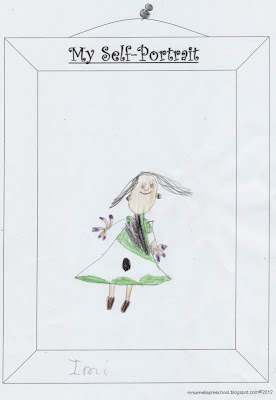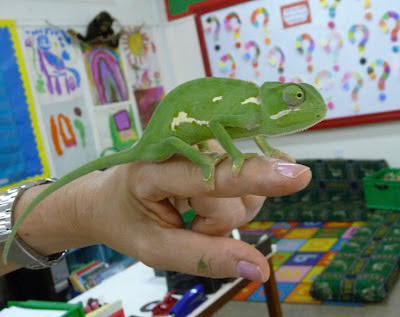The creative process of young children is fascinating and
multifaceted!
I have a writing center which I call “The Office Center”
where the children can create cards, letters, little books and whatever else
they want, like beards.
I add new materials periodically to keep it interesting. Last week I added a box with scraps and the children created lots of things.
"I made a beard!"
I add new materials periodically to keep it interesting. Last week I added a box with scraps and the children created lots of things.
The processes I witnessed were so diverse.
This girl begun and finished her work in
one go.
“It is a card for my sisters" she told me.
This other girl worked in a different way.
She made a card for her mum and during sharing time she wanted to show it to the class. She received very positive feedback about how she created a frame and her choice of colors.
Maybe inspired by
the feedback she decided to work on it some more.
"This is a card for my mum" she said again.
I placed it on a table to dry. Later in the day she
decided to add more details to it.
Then she came to me again and said, "My card for my
mum is ready!”
We need children to be free to create without judgement and without excessive guidelines. I like it when the children define the purpose and the audience for something they create. I also think it is important for them to share their work with their peers. They love to receive feedback and I love to see how proud they are of their work when talking about it.
I also believe that not only the process but also the product is important. The process because having fun creating something is a must and the product because it represents the result of an experience. That product will preserve the memories of fun times. The product usually has a purpose and this can be to decorate a room or to give to someone you love. I talk about audience and purpose with my students but I do not force the children to create with a purpose. I know that sometimes they are just exploring and having fun with the materials.
The little girl above had fun creating her card but I believe the pleasure she will get from giving it to her mom who will be proud and happy is even greater than the creative process. Her product is an expression of her love for her mother. Taken this into consideration how can I say that only the process is important?
I encourage my students to talk about the process and the product. If they cannot spontaneously talk about it I facilitate by asking questions and then I invite the group to ask questions too. This works quite well, but you need to model questioning to the group.
Children, like artists, need to be the judges of their own work. Artists don't create artwork to please art critics or the public. They create art because it there is something inside them that needs to come out, that needs to take a form, that needs to communicate. Children are the same. Children begin creating without fear of rejection. Unfortunately later in life they are stopped by their worse critics, their inner critics. How they develop that, then it's a whole different story.
I tell my students that a work is done when they think it's done. I do not set up a time. If we need to stop for some reason they can always go back to their work and finish it later. I have students who make lots and lots of artwork in very little time and others who take more than one day, sometimes a whole week to finish a work. I have students who ask me to continue to work during recess and others who ask me to take home an unfinished work because they want to finish it at home.
They are also free to change their minds about a work being finished or not. This is the case of the little girl in the last pictures. She is a great example of how the creative process is complex. She thought her card was done, decided it was not and worked it on it until she knew she had come to the final product.
As teachers we need to offer all kinds of materials and possibilities for the students to create and explore the world of art. The creative process is fascinating, all we have to do is to let it happen.
I also believe that not only the process but also the product is important. The process because having fun creating something is a must and the product because it represents the result of an experience. That product will preserve the memories of fun times. The product usually has a purpose and this can be to decorate a room or to give to someone you love. I talk about audience and purpose with my students but I do not force the children to create with a purpose. I know that sometimes they are just exploring and having fun with the materials.
The little girl above had fun creating her card but I believe the pleasure she will get from giving it to her mom who will be proud and happy is even greater than the creative process. Her product is an expression of her love for her mother. Taken this into consideration how can I say that only the process is important?
I encourage my students to talk about the process and the product. If they cannot spontaneously talk about it I facilitate by asking questions and then I invite the group to ask questions too. This works quite well, but you need to model questioning to the group.
Children, like artists, need to be the judges of their own work. Artists don't create artwork to please art critics or the public. They create art because it there is something inside them that needs to come out, that needs to take a form, that needs to communicate. Children are the same. Children begin creating without fear of rejection. Unfortunately later in life they are stopped by their worse critics, their inner critics. How they develop that, then it's a whole different story.
I tell my students that a work is done when they think it's done. I do not set up a time. If we need to stop for some reason they can always go back to their work and finish it later. I have students who make lots and lots of artwork in very little time and others who take more than one day, sometimes a whole week to finish a work. I have students who ask me to continue to work during recess and others who ask me to take home an unfinished work because they want to finish it at home.
They are also free to change their minds about a work being finished or not. This is the case of the little girl in the last pictures. She is a great example of how the creative process is complex. She thought her card was done, decided it was not and worked it on it until she knew she had come to the final product.
As teachers we need to offer all kinds of materials and possibilities for the students to create and explore the world of art. The creative process is fascinating, all we have to do is to let it happen.


















































